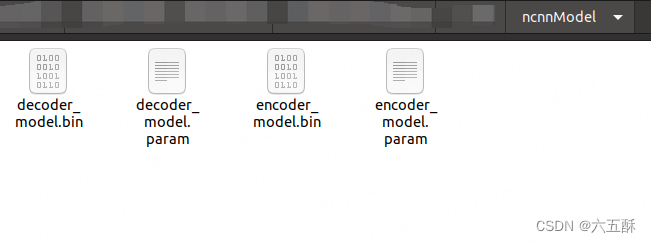系列文章
【如何训练一个中译英翻译器】LSTM机器翻译seq2seq字符编码(一)
【如何训练一个中译英翻译器】LSTM机器翻译模型训练与保存(二)
【如何训练一个中译英翻译器】LSTM机器翻译模型部署(三)
【如何训练一个中译英翻译器】LSTM机器翻译模型部署之onnx(python)(四)
目录
- 一、事情准备
- 二、模型转换
- 三、ncnn模型加载与推理(python版)
一、事情准备
这篇是在【如何训练一个中译英翻译器】LSTM机器翻译模型部署之onnx(python)(四)的基础上进行的,要用到文件为:
input_words.txt
target_words.txt
config.json
encoder_model-sim.onnx
decoder_model-sim.onnx
其中的onnx就是用来转为ncnn模型的,这里借助了onnx这个中间商,所以前面我们需要先通过onnxsim对模型进行simplify,要不然在模型转换时会出现op不支持的情况(模型转换不仅有中间商这个例子,目前还可以通过pnnx直接将pytorch模型转为ncnn,感兴趣的小伙伴可以去折腾下)
老规矩,先给出工具:
onnx2ncnn:https://github.com/Tencent/ncnn
netron:https://netron.app
二、模型转换
这里进行onnx转ncnn,通过命令进行转换
onnx2ncnn onnxModel/encoder_model-sim.onnx ncnnModel/encoder_model.param ncnnModel/encoder_model.bin
onnx2ncnn onnxModel/decoder_model-sim.onnx ncnnModel/decoder_model.param ncnnModel/decoder_model.bin
转换成功可以看到:

转换之后可以对模型进行优化,但是奇怪的是,这里优化了不起作用,去不了MemoryData这些没用的op
ncnnoptimize ncnnModel/encoder_model.param ncnnModel/encoder_model.bin ncnnModel/encoder_model.param ncnnModel/encoder_model.bin 1
ncnnoptimize ncnnModel/decoder_model.param ncnnModel/decoder_model.bin ncnnModel/decoder_model.param ncnnModel/decoder_model.bin 1
三、ncnn模型加载与推理(python版)
跟onnx的推理比较类似,就是函数的调用方法有点不同,这里先用python实现,验证下是否没问题,方面后面部署到其它端,比如android。
主要包括:模型加载、推理模型搭建跟模型推理,但要注意的是这里的输入输出名称需要在param这个文件里面获取。
采用netron分别查看encoder与decoder的网络结构,获取输入输出名称
有点问题,先把调试代码贴在下面了
import numpy as np
import ncnn# 加载字符
# 从 input_words.txt 文件中读取字符串
with open('config/input_words.txt', 'r') as f:input_words = f.readlines()input_characters = [line.rstrip('\n') for line in input_words]# 从 target_words.txt 文件中读取字符串
with open('config/target_words.txt', 'r', newline='') as f:target_words = [line.strip() for line in f.readlines()]target_characters = [char.replace('\\t', '\t').replace('\\n', '\n') for char in target_words]#字符处理,以方便进行编码
input_token_index = dict([(char, i) for i, char in enumerate(input_characters)])
target_token_index = dict([(char, i) for i, char in enumerate(target_characters)])# something readable.
reverse_input_char_index = dict((i, char) for char, i in input_token_index.items())
reverse_target_char_index = dict((i, char) for char, i in target_token_index.items())
num_encoder_tokens = len(input_characters) # 英文字符数量
num_decoder_tokens = len(target_characters) # 中文文字数量import json
with open('config/config.json', 'r') as file:loaded_data = json.load(file)# 从加载的数据中获取max_encoder_seq_length和max_decoder_seq_length的值
max_encoder_seq_length = loaded_data["max_encoder_seq_length"]
max_decoder_seq_length = loaded_data["max_decoder_seq_length"]encoder_model = ncnn.Net()encoder_model.load_param("ncnnModel/encoder_model.param")
encoder_model.load_model("ncnnModel/encoder_model.bin")decoder_model = ncnn.Net()
decoder_model.load_param("ncnnModel/decoder_model.param")
decoder_model.load_model("ncnnModel/decoder_model.bin")def decode_sequence(input_seq):# Encode the input as state vectors.ex_encoder = encoder_model.create_extractor()ex_encoder.input("input_1", ncnn.Mat(input_seq))_, LSTM_1 = ex_encoder.extract("LSTM__31:1")_, LSTM_2 = ex_encoder.extract("LSTM__31:2")print(LSTM_1)print(LSTM_2)# Generate empty target sequence of length 1.target_seq = np.zeros((1, 1, 849))# Populate the first character of target sequence with the start character.target_seq[0, 0, target_token_index['\t']] = 1.# this target_seq you can treat as initial state# Sampling loop for a batch of sequences# (to simplify, here we assume a batch of size 1).stop_condition = Falsedecoded_sentence = ''while not stop_condition:ex_decoder = decoder_model.create_extractor()print(ncnn.Mat(target_seq))print("---------")ex_decoder.input("input_2", ncnn.Mat(target_seq))ex_decoder.input("input_3", LSTM_1)ex_decoder.input("input_4", LSTM_2)_, output_tokens = ex_decoder.extract("dense")_, h = ex_decoder.extract("lstm_1")_, c = ex_decoder.extract("lstm_1_1")print(output_tokens)print(h)print(c)print(fdsf)output_tokens = np.array(output_tokens)h = np.array(h)c = np.array(c)print(output_tokens.shape)print(output_tokens.shape)print(h.shape)print(c.shape)#print(gfdgd)#output_tokens, h, c = decoder_model.predict([target_seq] + states_value)# Sample a token# argmax: Returns the indices of the maximum values along an axis# just like find the most possible charsampled_token_index = np.argmax(output_tokens[0, -1, :])# find char using indexsampled_char = reverse_target_char_index[sampled_token_index]# and append sentencedecoded_sentence += sampled_char# Exit condition: either hit max length# or find stop character.if (sampled_char == '\n' or len(decoded_sentence) > max_decoder_seq_length):stop_condition = True# Update the target sequence (of length 1).# append then ?# creating another new target_seq# and this time assume sampled_token_index to 1.0target_seq = np.zeros((1, 1, num_decoder_tokens))target_seq[0, 0, sampled_token_index] = 1.# Update states# update states, frome the front partsstates_value = [h, c]return decoded_sentenceimport numpy as npinput_text = "Call me."
encoder_input_data = np.zeros((1,max_encoder_seq_length, num_encoder_tokens),dtype='float32')
for t, char in enumerate(input_text):print(char)# 3D vector only z-index has char its value equals 1.0encoder_input_data[0,t, input_token_index[char]] = 1.input_seq = encoder_input_data
decoded_sentence = decode_sequence(input_seq)
print('-')
print('Input sentence:', input_text)
print('Decoded sentence:', decoded_sentence)

)
)



)









9.1-协议数据单元PDU)

